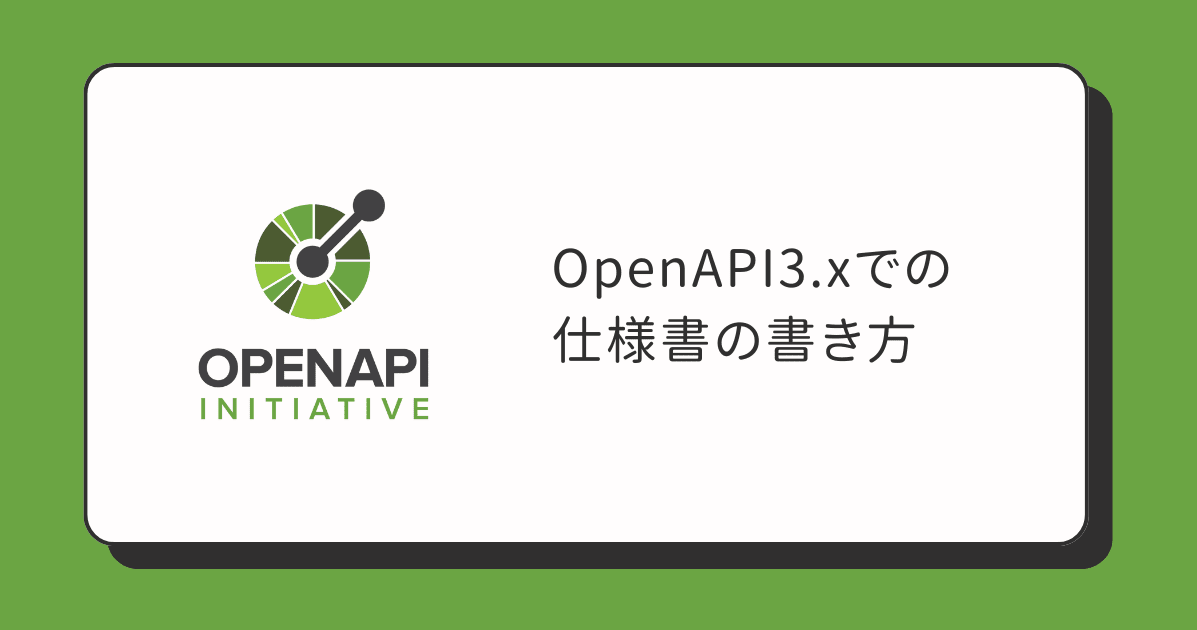
OpenAPI3.xでの仕様書の書き方
SBJソリューション部のserinaです。
先日、OpenAPIで仕様書を作成する機会がありました。
つまずいた点が何個かあったので書き方をまとめておきたいと思います。
バージョン
バージョン: OpenAPI 3.0.3
作成ファイル形式: yml
(UIツール: Swagger UI)
作成したパス構造
src/
│
├── paths/
│
├── responses/
│
├── schemas/
│
└── index.yml
- paths ... APIの定義ファイルを格納
- responses ... レスポンスの定義ファイルを格納
- schemas ... スキーマの定義ファイルを格納
- index.yml ... 他のファイルを呼び出すメインファイル
書き方
決まった値が入る場合はenumを定義
ステータスなどのプロパティで0か1など、決まった値が入る場合は、enumで定義しておくことができます。
status:
type: integer
enum: [0, 1]
type: integerの場合はformatを定義できる
status:
type: integer
format: int64
定義できるformatは、このパターンになります。
| type | format |
|---|---|
| number | – |
| number | float |
| number | double |
| integer | – |
| integer | int32 |
| integer | int64 |
最小・最大値はminLengthとmaxLengthを使用
date:
type: string
minLength: 8
maxLength: 8
正規表現はpatternで定義
yyyyMMdd形式など、決まった形式がある場合はpatterに定義します。
date:
type: string
pattern: '^\d{4}(0[1-9]|1[0-2])(0[1-9]|[12]\d|3[01])$'
共通化して呼び出したい
共通化したい箇所は、$refを使用することで参照可能です。
paths:
/users/{id}:
get:
summary: Gets a user by ID.
response:
'200':
description: OK
content:
application/json:
schema:
$ref: '#/components/schemas/User'
'401':
$ref: '#/components/responses/Unauthorized' # <-----
'404':
$ref: '#/components/responses/NotFound' # <-----
# Descriptions of common components
components:
responses:
NotFound:
description: The specified resource was not found
content:
application/json:
schema:
$ref: '#/components/schemas/Error'
Unauthorized:
description: Unauthorized
content:
application/json:
schema:
$ref: '#/components/schemas/Error'
schemas:
# Schema for error response body
Error:
type: object
properties:
code:
type: string
message:
type: string
required:
- code
- message
descriptionを別で記載したいときは、responsesではなくschemasに定義して呼び出します。
パスの指定の仕方
$ref: '#/components/schemas/User'
# の前にファイルパスがない場合は、現在のファイル内の参照という意味になります。
$ref: './schemas/user.yml#/User'
# の前の ./schemas/user.yml は参照先のファイルパスで、
# 以降の /User は、そのファイル内の User を呼び出しています。
一部だけ参照したい
参照したい箇所とインラインで書きたい箇所が混在している場合は、allOfを使用します。
schemaを$ref参照し、exampleは別で定義したい
responses:
'200':
description: OK
content:
application/json:
schema:
allOf:
- $ref: '#/components/schemas/User'
- type: object
example:
id: abcde12345
例が複数ある場合は複数形のexamplesを使う
responses:
'200':
description: OK
content:
application/json:
schema:
allOf:
- $ref: '#/components/schemas/User'
- type: object
examples:
example1:
summary: First example
value:
id: abc123
example2:
summary: Second example
value:
id: 321cba
$ref参照して一部を上書き
参照する箇所としない箇所が混在し、かつ、一部上書きしたい場合はこう書きます。
responsesのdescriptionを上書き
responses:
'403':
allOf:
- $ref: '#/components/schemas/User'
description: 403 Forbidden
parametersのexampleを上書き
parameters:
- allOf:
- $ref: '#/components/schemas/User'
- example: xyz987
個人的につまずいた点や気づいた点
- allOfの使い方
- exampleとexamplesを書く階層の違い
- 再利用したい定義は別ファイルで定義して呼び出す方がすっきりと書ける
参考
最後に
初めて書いたので慣れないうちは時間かかったのですが、慣れるとサクサク書いていけました!
工夫次第でもっとシンプルでわかりやすい構造で書いていけるのではないかなと思います。







